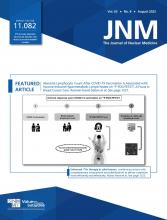John Morris, MBBS, who made pioneering and influential contributions in Australia by taking radionuclide techniques from the research laboratory into clinical practice and by training the first generation of Australian nuclear medicine specialists, died in May. He was instrumental in bringing cyclotrons and PET to Australia, culminating in the official opening of the National Medical Cyclotron and the Royal Prince Alfred Hospital (RPAH) Sydney PET program in March 1992.
John Morris,MBBS, at the National Medical Cyclotron, Sydney, Australia, 1992.
After graduating in medicine from the University of Sydney and completing residency in 1963, Morris became a clinical tutor in the Medical School at Sydney University. It was there that he met James McRae, MBBS, PhD, a physician and senior lecturer in medicine who had obtained his doctorate in medical physics in the 1950s at the Donner Lab (Berkeley, CA), where E.O. Lawrence, PhD, had developed the first cyclotron and won the 1939 Nobel Prize in Physics. McRae wanted to create a radiation medicine unit within the Medical School in Sydney, and Morris was attracted to this interesting new development. Their group carried out tracer (nonimaging) studies to investigate physiologic pathways in disease, unlike most other radioisotope units in Australia at the time that focused mainly on thyroid disease.
Morris oversaw, along with McRae, the movement of this service into clinical practice at RPAH in 1967. McRae was appointed as director of Diagnostic Isotope Services at RPAH, and Morris was appointed as the first nuclear medicine physician and eventually department head when McRae returned to the Donner Lab in 1971. Morris remained director of nuclear medicine at RPAH until 1999. His long career spanned the early days of radioisotope tracer studies, the first imaging studies using the rectilinear scanner and then the gamma camera, to tomographic imaging with SPECT and the introduction of PET.
McRae and Morris lobbied in the 1960s for the Australian Atomic Energy Commission (AAEC; forerunner of the Australian Nuclear Science and Technology Organisation), which operated Australia’s only nuclear reactor, the 10-MW High Flux Australian Reactor, to become involved in radionuclide production for nuclear medicine and to add a cyclotron in Australia. They succeeded in their first goal around 1970, establishing a daily delivery of radiopharmaceuticals from the AAEC site in Sydney to all Australian capital cities, but it would be more than 20 years before the first cyclotron for medical radionuclide production came online in Australia.
Morris’s continued advocacy for a medical cyclotron was instrumental in the decision of the Australian government in the 1980s to fund a National Medical Cyclotron, the first in Australia, and to support a proposed PET facility at RPAH. In preparation for the introduction of PET, Morris was responsible for creating a program that sent early career scientists, physicians, and technologists to train in internationally renowned PET centers, providing the opportunity to spend time overseas and return with knowledge and enthusiasm to implement this technology.
Perhaps more than anyone, Morris was instrumental in establishing nuclear medicine in Australia as a specialty of internal medicine staffed by physicians and strongly resistant to integration into radiology. His colleagues were not always in agreement, although his success in attracting and training a generation of nuclear medicine physicians who eventually led a large number of nuclear medicine departments around the country is a defining legacy of his vision and commitment to the field.
Morris also made an impact on the international nuclear medicine stage. He had a long association with the International Atomic Energy Agency (IAEA) and in 1967 accepted a 4-month assignment from the IAEA to establish a nuclear medicine department at Panduri Hospital (Bucharest, Romania). This led to an ongoing association between the IAEA and Morris’s department at RPAH, which became the host site in Australia for IAEA regional training courses in physics, instrumentation, and computing, plus serving as the main site for development of the Distance-Assisted Training program for technologists. This program was extraordinarily successful and was rolled out throughout the region, translated into many languages, and eventually used in Latin America, producing more than 1,200 nuclear medicine technologist graduates in developing and emerging countries.
Morris had numerous interests outside his professional life. He owned a racehorse agistment and stud property near Sydney, and horse racing was a great interest. He helped introduce nuclear medicine bone scanning in performance horses in Sydney, later extending to small animal veterinary practice at the university in dogs and cats. He was widely read, with an extensive library, especially of Australian literature, and collected paintings by well-known Vietnamese artist Bui Xuan Phai.
After retiring from RPAH Morris remained active in lobbying for wider recognition of nuclear medicine procedures and expansion of the range of studies that could be undertaken. He received numerous awards, including the Australian Nuclear Association Award (the first medical graduate to receive this) and Honorary Life Membership in the Australian and New Zealand Society of Nuclear Medicine. He was made an Officer of the Order of Australia, one of Australia’s highest honors, in 1999 “for service to the development of nuclear medicine through the establishment of the national medical cyclotron and the nuclear medicine PET centre.” Morris will remain for many, quite literally, the father of Australian nuclear medicine.
- © 2022 by the Society of Nuclear Medicine and Molecular Imaging.








